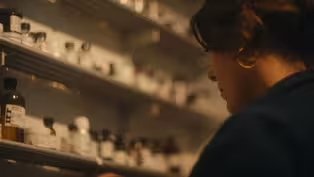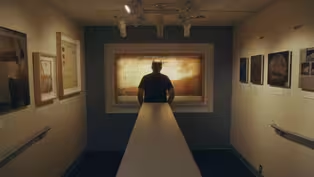
Larry Bell’s Time Machine Lets Viewers Feel Time
Clip: Season 15 Episode 2 | 5m 38sVideo has Closed Captions
Two viewers sit opposite each other with a special pane of glass between them.
To create the effect for his work, Time Machine, Larry Bell exposed panes of glass to a vacuum process using a machine used previously in the film industry. The result is a piece of glass that is simultaneously transparent and reflective. Time Machine is both a study of light and a performance piece. Two viewers sit opposite each other with the pane of glass fixed in a “window” between them.
Problems playing video? | Closed Captioning Feedback
Problems playing video? | Closed Captioning Feedback
Artbound is a local public television program presented by PBS SoCal

Larry Bell’s Time Machine Lets Viewers Feel Time
Clip: Season 15 Episode 2 | 5m 38sVideo has Closed Captions
To create the effect for his work, Time Machine, Larry Bell exposed panes of glass to a vacuum process using a machine used previously in the film industry. The result is a piece of glass that is simultaneously transparent and reflective. Time Machine is both a study of light and a performance piece. Two viewers sit opposite each other with the pane of glass fixed in a “window” between them.
Problems playing video? | Closed Captioning Feedback
How to Watch Artbound
Artbound is available to stream on pbs.org and the free PBS App, available on iPhone, Apple TV, Android TV, Android smartphones, Amazon Fire TV, Amazon Fire Tablet, Roku, Samsung Smart TV, and Vizio.
Providing Support for PBS.org
Learn Moreabout PBS online sponsorshipI keep thinking of something that one of my heroes said, a painter named William de Kooning.
He said the most important thing about art is its total uselessness.
I like that.
Glass is available anywhere.
It's not very expensive, and it's part of our civilization.
And it has the ability to transmit, reflect and absorb light all at the same time.
And with this technique, it's possible to change any one of those things and make that piece of glass do something that's quite improbable.
That's what I like about what I do.
It's improbable.
Larry Bell is sort of part of this really pioneering and, you know, important generation of California artists that were working outside what was then, you know, you could see is that sort of mainstream of modernism.
They were working in a different geographic context, a different cultural context.
He was really one of the pioneers, I think, in terms of thinking about and translating through art how humans perceive light and color and space.
There are, you know, I think, many instances of artists looking to the sciences to different sort of spheres of technology, pillaging them for ideas, but also know for equipment, for materials that they can then bring into their art making.
I found this technique called front surface mirrors that was used in the film business.
The man who did the coatings had a piece of equipment that he wasn't using, and he offered to sell it to me.
It was a high vacuum thermal evaporator.
All I have to do is learn what it was all about.
I had no idea it was as exotic as it was.
Technical name for the device was a Kinney P5, whatever that meant.
Larry's ability to be moved by light and have that drive him to then learn how to operate high tech equipment to create that experience for others is profound in what makes Larry unique.
He's basically fully self-taught.
You know, everything he learned about, you know, the best pigments to deposit and the processes by which he does them.
Like that was all just trial and error, which I mean, ultimately is the scientific process.
But this is the Time Machine.
I found this window at the Los Alamos dump.
I have no idea what they did with it, except they looked through it.
It's a very special piece of glass that filters out all of the infrared.
The time machine is a is a piece in which two individuals sit across from each other.
Between them is a window.
Half of the light from you travels through to the person, opposed from you, and half of that light reflects back towards you.
The physics of that has to do with the coatings of metal that exist on that glass, the type of glass it is.
The consequence of that is an experience.
Light that is illuminating my body in this reflection is traveling at 186,000 miles a second to get back to my eyes.
What I like is what I sense of their feeling of themselves when they sit down in these chairs.
Some people seem to get very frightened, and some people just find it totally amusing.
If you're sitting across from someone, that person that you're seeing, at the same time that you're seeing yourself exists at a different age and at a different moment in time.
So you're not seeing the person as they are now, but as they were some moment in time in the past.
One of the things that I think every astronomer uses in their outreach talks is trying to say, looking at the sky is like a time machine, depending how far you look like that light that left its source when the dinosaurs roamed the Earth, right?
It's one of these things that just sort of captures you.
When.
When I sat in it, we sat across from one another.
It felt like I didn't know my place in time.
Really?
Yeah, well, everybody gets- everybody that does that has a has a very special feeling.
I've had people jump out of the chair.
The only thing I can deduce from people's response is that they're feeling the speed of life.
There by the instant time machine.
Blended Worlds: The Fusion of Art & Science at JPL (Preview)
Preview: S15 Ep2 | 30s | NASA’s Jet Propulsion Laboratory transforms science into awe-inspiring creative projects. (30s)
The First Picture of Mars was Drawn in Crayon
Preview: S15 Ep2 | 1m 24s | The very first image of the red planet was made with pastel crayons. (1m 24s)
Providing Support for PBS.org
Learn Moreabout PBS online sponsorshipSupport for PBS provided by:
Artbound is a local public television program presented by PBS SoCal













